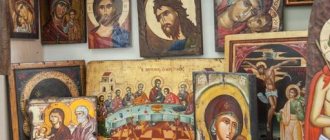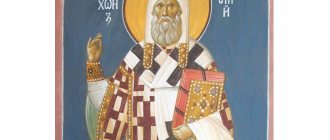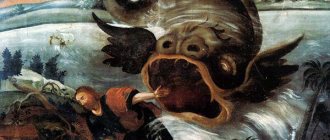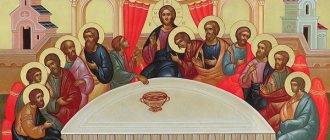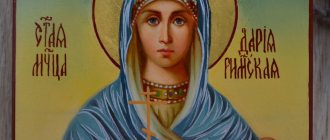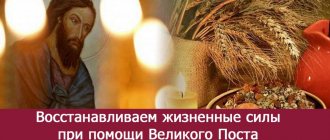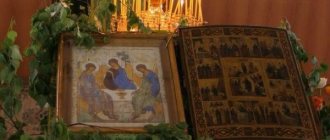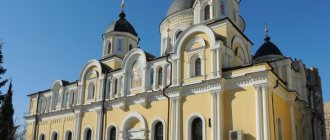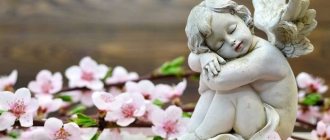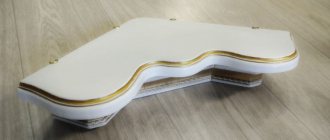On my own - practically nothing. You can find out the real price of the icon by contacting professionals in an antique salon. The appraisers and experts with whom the salon cooperates will conduct a thorough inspection and evaluate the shrine. During the evaluation process, they analyze the base, study the soil using probing techniques, and examine the painting itself under a microscope.
Question and answer What is myrrh streaming?
And what are they looking at?
“There are many factors here. As a rule, the main thing is the level of writing: a school letter or a village icon written in cursive. Thus, icons painted using cursive technique have a low cost. The price is also affected by the century when the icon was painted and its size. Items can be of various types: there are folding travel icons, there are copper-cast icons, there are copper-cast plastic icons, and there are icons of a serious gift level. Various schools of icon painting are also important. So the price can depend on a lot of things. There are independent expert centers in Russia, quite a lot of them. They issue examinations. These are not antique stores, but directly expert centers that conduct assessments without a commercial offer. The icon can also be appraised by some museums that conduct examinations,” says appraiser Daniil Shpilevoy .
The meaning of saints in Orthodoxy
Saints in Orthodoxy are needed in order to turn to them in moments of sorrow or despair, when there is no way to solve the problem on your own. They are often consulted for incurable illnesses or problems at home. Girls may ask about finding a lover or about the possibility of conceiving a child.
Icons are placed in shrines: churches, chapels, monasteries. The saints served as patrons of the sacred place, as well as the city that is located closest to the image. Also, each icon shows a different type of scripture, which indicates the development of iconography.
Names and meanings of the most important and Orthodox images
Most of the images of saints are associated with the face of the Mother of God or other righteous people:
- Saint Nicholas;
- Seraphim of Sarov;
- St. George the Victorious;
- Peter and Fevronia;
- Healer Panteleimon.
"Semistrelnaya"
Initially, the Seven-Arrow Icon was located near the Toshni River, and it was found by a peasant. It is not known exactly who painted the image. The approximate date of creation falls on the 18th century. The name comes from the image on the canvas of the Virgin Mary, who was pierced by seven arrows.
The icon protects against illness and helps to come to terms with loss. Now there are beautiful lists from it.
"Inexhaustible Chalice"
The Inexhaustible Chalice is an icon that first appeared in 1878, but was lost by 1929. Known lists from it are located in the Vysotsky and Vladychny monasteries. The canvas depicts the Mother of God with her hands raised in prayer along with the Child.
"Healer"
The famous icon “Healer” was painted around the 4th century. Previously it was located in the temple of Kartalinya. The story of the icon tells about the healing of a monk who fervently prayed to the Mother of God at the time of a serious illness. Miraculous copies of the icon are located in several monasteries.
"Unexpected Joy"
The icon “Unexpected Joy” was first described in 1683; the exact date of its creation is unknown. Church history says that the sinner always prayed before committing unrighteousness. Then he received a vision where the Mother of God and her Son talked about punishing sinners. After the Mother’s prayer, Jesus forgave the man who saw the vision. This plot is depicted in the picture.
"Three-handed"
The “Three-Handed” icon is an image of the Mother of God, which is revered by the Orthodox Church. The painting was transferred to Sava's monastery until the 13th century, after which it was transferred to the Hilandar monastery. The story goes that the monks placed the icon on the altar, but it was moved to the abbot's place. Its lists are located in Bulgaria, Russia, Ukraine. “Three-handed” means “the owner of three hands,” since this is how the Mother of God is depicted in the painting.
"Quick to Hear"
“Quick to Hear” is an image of the Mother of God, which is considered miraculous. On the lists she is depicted with a Baby in her arms. The story goes that the monk deliberately smoked the holy face because he did not believe that he heard a voice from him. Then the Mother of God sent blindness to him. After many years of prayer, the monk regained his sight, and the icon gained fame. The lists are located in Moscow, Przemysl, Kazan, Dochiar.
Seraphim of Sarov
Seraphim of Sarov was elevated to sainthood during his lifetime; people turn to his image when they lose strength. He believed that the worst thing for a person is to fall into despondency, so his face protects the believer from deep sorrow and despair. Seraphim also helps to resist temptations and sinful thoughts. Merchants believe that the image of Saint Seraphim improves sales and promotes success in business.
St. George the Victorious
St. George the Victorious is considered one of the most revered saints in the Orthodox world. It is generally accepted that he died during the Great Religious Persecution, when he was caught and tortured for 8 days. After this he was beheaded. This happened in 303 or 304. The saint is considered the patron saint of warriors and those who fight for a righteous cause. Also, prayers to his icon improve crops and protect livestock from diseases.
Nikolai Ugodnik the Wonderworker
The icon of the Wonderworker helps those who have lost faith and returns them to the true path. Throughout his life, Saint Nicholas helped people regain their faith and worked miracles, returning food to the hungry. His deeds are the most popular and revered because of his strong faith and purity of thoughts. The saint always sought solitude to read the Bible, as well as helping those who needed it.
Our Lady of Vladimir
The Icon of the Vladimir Mother of God is the most famous and revered painting among the Russian Church. There is an opinion that it, just like the Iveron image, was written by the Evangelist Luke. In Rus', the image appeared in the 12th century, in the 14th century it was placed in Moscow to protect the city from attack. The icon was moved from Vladimir to Moscow several times, after which in the mid-20th century it was transferred to the Tretyakov Gallery. It is customary to ask the image for patronage in business, good luck in endeavors and protection from bad intentions.
"Burning bush"
“The Unburnt Bush” (or bush in translation) is an iconographic type, and not a full-fledged image, like other saints. The painting depicts famous prototypes of the incarnation of Christ, which are revered in Orthodoxy. Her list is located in Ukraine. You can ask the icon for guidance on the righteous path.
Iveron icon
The Iveron Icon is located on Mount Athos, in the Iveron Monastery. This is an image of the Mother of God with a baby in her arms. Supposedly it was painted by Luke, the evangelist and first icon painter. Its lists are located all over the world, including the Caucasus, Russia, France. The first list was written for the Moscow monastery, but was lost during the Soviet Union.
Its exact location is unknown.
"Eternal Color"
“The Unfading (or Fragrant) Flower” is an icon that is revered in the Orthodox religion. It was created approximately in the 17th century on Mount Athos or in Constantinople, according to other sources. The painting depicts the Virgin and Child in an unusual design, as there is a frame of flowers on the canvas.
They ask the icon for children and the health of their offspring.
"Tenderness"
There are several variations of the Tenderness icon:
- Novgorodskaya.
- Starorusskaya.
- Podkubenskaya.
- Pskov-Pecherskaya.
- Serafimovo.
Except for the last one, all of them depict the face of the Mother of God and the Child. The basis of the plot is the Mother holding her Son in her arms. The Seraphim icon was kept in the saint’s cell for a long time.
Kazan Icon of the Mother of God
The Kazan Icon is one of the miraculous icons; it first appeared in 1579. She is most revered in the Russian Church. There is a Moscow list that was sent to Tsar Ivan the Terrible. Ancient legends say that the icon appeared when Kazan was almost burned down. You can ask the image for protection of the hearth and safety of things.
Ostroobramskaya
The Ostrogramskaya icon is revered not only in Russia, but also in Poland and Belarus. It is located in Vilnius, on the city gates as a protective image. The painting depicts the Mother of God without the Child, who folds her hands and looks at them. The image appeared around the 15th century. You can ask him for the protection of religion and your beliefs, since the icon is revered equally by Orthodox and Catholic believers.
"The Unbreakable Wall"
“The Unbreakable Wall” is not a specific icon, but an image of Our Lady Oranta. This can be called any image that corresponds to the canons. The mosaic image is located in Kyiv, in the St. Sophia Cathedral. The celebration takes place at the end of May. You can ask Our Lady for the search for love and family well-being.
Mourning
The mourning icon is the face of the Mother of God, who experiences the death of her Son. She raises her hands in prayer and looks up. The image is kept in the Holy Trinity Monastery. You can ask the face for the repose of the soul and the pacification of grief.
"The Joy of All Joys"
“The Joy of All Joys” is an image of the Mother of God that was in the cell of Seraphim of Sarov for a long time. Its alternative name is “Tenderness of Seraphimo.” Throughout the saint's life, the Mother of God was his protector, so prayers to him can also be heard by the Queen. You should ask the icon for the cure of serious illnesses.
"The Holy Trinity"
The “Holy Trinity” icon was painted by Andrei Rublev and is currently kept in the Tretyakov Gallery. This icon is considered one of the most famous in the Russian Church. They wrote lists based on it, which are located in different parts of Russia. The main faces of Abraham, Sarah, and Lot are written on the image.
"Recovery of the Dead"
The Icon of the Mother of God “Seeking the Lost” is an image of the Mother of God that was created in the 17th century. The name was given because of Theophilus' story of repentance. According to its text, Theophilus prayed before the image of the Mother, whom he later called “Seeking the Lost.”
"The Tsaritsa"
The “Tsaritsa” icon is an image of the Mother of God with the Child in her arms, surrounded by angels. The image is located in the Athos monastery of Vatopedi. Its writing dates back to the 17th century. The image is considered miraculous, as there have been known cases of cancer cures after prayers to it.
"The Omen"
“The Sign” is another face of the Mother of God, which was depicted according to the Orant type. At the moment, the image is located in the St. Sophia Cathedral of Veliky Novgorod. The miracles of the icon were first mentioned in 1170, when Novgorod was attacked, but the Mother of God drove the enemy away from the city gates. You can ask the image for protection in business, protection from evil tongues.
"The Bread Wrangler"
The rarest, but deeply revered icon of the Mother of God is the “Spreader of the Loaves.” The image shows the Virgin Mary with her hands raised to the sky, seated on the clouds. The image was painted in 1890, after which the Kaluga province miraculously got rid of famine. You can ask Our Lady for help in earning money and protecting grain fields.
Great Martyr and Healer Panteleimon
The Great Martyr Panteleimon was not only a deeply religious man, but also a doctor and healer. In the Orthodox Church, his image is revered in the treatment of serious illnesses, but in the Catholic faith he is not so popular. They ask his icon for good health and strong offspring.
Blessed Matrona of Moscow
Matrona of Moscow had the ability to see the future due to her deep faith and complete lack of vision. The saint healed people and gave them good health. You could confess to her and get clean. There is an opinion that she was able to predict her death in 3 days, but still continued to help people. You can ask her image for the forgiveness of loved ones, the health of children and relatives.
Peter and Fevronia
On many icons, saints are depicted alone or, if it is the Mother of God, then together with the Child. Therefore, the icon of Peter and Fevronia is a rare exception. Their joint image symbolizes the unity of the family and the strength of the love connection. You can ask their image to find a lover and peace in the family.
Saint Nicholas
Saint Nicholas is Nicholas the Pleasant, at whose image one prays for deep faith and success in business.
What determines the cost of a shrine?
The biggest misconception among non-specialists is that the older the icon, the more expensive it is. Not at all! The cost of an image is influenced by many factors. When thinking about how to find out the cost of an icon, do not forget about the following components of the assessment:
- Image dimensions.
- Who is depicted in the icon? (Different saints are in demand in different ways, and different subjects are also in demand in different ways.)
- The art of writing.
- Icon painter.
- Material.
- The uniqueness of the icon.
It is believed that the easiest to sell are icons that depict Jesus Christ in the image of the Lord Pantocrator, the Most Holy Theotokos, St. Nicholas the Wonderworker and St. George the Victorious. Such images have long been kept in the homes of Orthodox believers, and their prevalence today is no less. On the other hand, the rarer the image is, the more expensive it is, accordingly.
